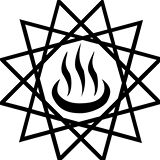Agathos Daimon means “good spirit” and is a religious observance held on the second day of each lunar month, immediately following the Noumenia. It is the third celebration of a trio of household monthly observances. A good spirit usually refers to a type of divine being that is less powerful than a God, is personal to each family, and can bring the family good luck, protection, or some type of assistance. Household spirits are usually seen as either snakes or as a young man with a horn of plenty in hand.
Some celebrate the Agathos Diamon by pouring a libation to the spirit and asking for his continued blessings on the family. If there is something in particular that your family wishes help with, give an additional offering to your family’s protective spirit. Although we know we can always approach the Gods directly, the Agathoi Diamones are seen to be helpful intermediaries between the Gods and man.
The second day of every Athenian month was also a sacred day, devoted to the Agathos Daimon (good spirit). The name daimon does not mean the evil demon of modern Christianity, (although it did have a negative form, called the kakodaimon), but was thought to be an aspect of Zeus, as Zeus Ktesios, Charitodotes, and Epikarpios, titles as giver of increase and joy. Agathos Daimon is most often represented in the form of a snake, a symbol of healing. However the daimon is also a function of one’s being, a characteristic inherently neither good nor bad. Hence, one prays for a good daimon, an eudaimon, and goodness from the gods for the coming month and also for the favor of father Zeus as Agathos Daimon. Burkert (Greek Religion, p. 181) says that “One must be on good terms with it.” And Pindar sang that “The daimon active about me I will always consciously put to rights with me by cultivating him according to my means” (Pyth. 3.108f) and “The great mind of Zeus steers the daimon of the men whom he loves” (Pyth. 5.122f). The philosopher Sokratēs talks of his own daimon as a small voice which speaks to him and warns him to refrain from certain actions (Plato, Apology, 31d).
In Greek lunar calculations, the second day of the month is the one during which the new crescent moon is most likely glimpsed. In this form it most seems to have “two horns,” especially as it sets. The Orphic Hymn 9, to Selene, the Moon, describes her as taurokeros, “bull horned.” Thus the crescent moon resembles the top of the kerykeion, the staff of Hermēs, where the two serpents, the Agathos Daimon (the “spirit of abundant goodness”) and Agatha Tychē (“good fortune”), form an open circle and a complete circle below, representing the phases of the moon (the Roman embellished the kerykeion with wings to form the more familiar caduceus). Hermes carries the kerykeion as messenger of the Gods and bringer of goodness and good fortune.
Agathos Daimon is also associated with Dionysos, especially with His gift of wine. A feast was often closed with a small drink of unmixed wine, called either Agathos Daimon or Zeus Soter (savior), as though supplicating the god that they may do nothing indecent or have too strong a desire for the drinking, and may receive from it all that is noble and salutary (Athenaeus, XV, 693 d).
Many modern Hellenes follow the practice of pouring a libation to their own Agathos Daimon on the second day of the lunar month. Possible prayers include the Orphic Hymn 73 (to the Daimon, that is, Zeus). Also, whenever you see a snake, give a prayer to Agathos Daimon and even pour a libation. In Hellenistic and Roman times, family ritual areas were often decorated by snakes, according to information presented on the Labrys site.
Aeschylus in the Suppliant Maidens says: “May Zeus grant that it go well with us. For Zeus’ desire is hard to trace: it shines everywhere, even in gloom, together with fortune obscure to mortal men” (86-90). Kleanthēs prays: “Lead me, O Zeus, and thou O Destiny (Epictetus, Discourses, book four, chapter 1) and also, “If so it pleases the Gods, so let it be.”
Note: the above is an expansion of an article written by Bob Clark.
